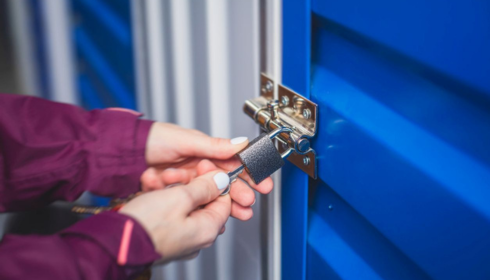Security has become the defining factor for how people choose self-storage today. It’s no longer enough for a facility to offer space—modern storage must protect what people can’t afford to lose. The strongest facilities blend digital tracking, controlled access, physical barriers, and environmental protection into one system.
Digitally Logged Access That Tracks Every Unit Entry
Digital gate systems record every entry tied to a personalized access code. This creates a consistent log of who entered the property, at what time, and how long they stayed. The system removes anonymous access, giving facility managers a clear movement trail if a concern ever arises.
The technology does more than open gates—it creates accountability. Facilities that use digital access can pair time-stamped entries with surveillance or on-site reports when investigating incidents. For customers searching storage units near me, this layer of traceability offers reassurance that the building knows who comes and goes at all times.
Perimeter Controls That Limit After-hours Property Entry
Fenced boundaries and restricted gate hours form the first line of defense against unwanted entry. Many properties automatically shut down external vehicle access at night, ensuring movement inside comes only from approved guests during scheduled hours. This prevents roaming traffic and limits exposure during high-risk times.
Even late-night access requests aren’t left to chance. Systems can grant temporary clearance without leaving gates open for general entry. This controlled approach means less footfall at vulnerable hours and fewer opportunities for unauthorized roaming around units or parked vehicles.
Temperature-regulated Units That Prevent Moisture Damage
True climate controlled storage does more than stabilize temperature—it protects against humidity swings that warp wood, corrode metal, fade fabrics, and ruin electronics. These units regulate moisture levels and air quality, guarding valuables even when doors stay closed for months at a time.
Environmental protection is often unnoticed until it fails. Without regulation, condensation forms behind walls and ceilings, eventually settling into boxes, furniture fibers, and stored machinery. Climate regulation stops the damage before it ever starts, preserving contents without requiring owner intervention.
Motion-activated Interior Lighting That Reduces Blind Spots
Lighting is a security tool, not just a convenience feature. Motion-triggered LED lighting eliminates dark corners inside hallways, unit rows, and drive aisles. Sensors activate only when movement is detected, increasing visibility without wasting power.
Bright spaces deter unwanted activity and help customers navigate their belongings safely. The real advantage is the removal of blind zones, which are often exploited in poorly lit storage designs. Automated lighting ensures every movement inside the facility has visibility that cameras and staff can monitor.
High-ceiling RV spaces built with controlled entry points
Storage designed for oversized vehicles needs more than height—it requires security that matches the scale. RV storage units are built with tall clearance bays, reinforced gating, and entry points limited to registered users. These spaces protect large investments like motorhomes, campers, and travel trailers.
Wide drive paths, defined turn points, and restricted access zones prevent accidental entry from general storage traffic. Because these units house high-value assets, facilities often combine them with camera coverage, fenced enclosures, and individualized entry controls rather than open-lot parking.
Unit Door Integrity Designed to Resist Forced Tampering
Storage doors built with reinforced metals, tight latch alignment, and anti-pry edges make forced break-ins significantly more difficult. The goal is deterrence through design—weak points are removed before they become targets.
Tamper-resistant doors also pair with lock channels that hide vulnerable hardware from bolt cutters or leverage tools. When doors are engineered as part of the security system, breaches shift from “easy opportunity” to “unlikely event,” changing the risk equation for anyone attempting damage or access without permission.
Layered Property Fencing That Adds an Outer Security Line
Perimeter fencing isn’t a single wall—it’s a layered boundary that forces approach visibility. Tall fencing, locked gates, anti-climb tops, and structured entry points make random access difficult long before anyone reaches individual units. It creates distance between the public exterior and the private storage interior.
Fencing also controls direction. By channeling vehicle and foot traffic into monitored paths, it limits untracked movement. When combined with lighting and cameras, layered barriers shift the property from passive storage to active controlled space.
Gate Checkpoints That Verify Authorized Access
Customers can be confirmed, IDs matched, rental agreements verified, and gate permissions adjusted before access is granted. This small interaction reduces unauthorized gate sharing, tailgating, and borrowed entry codes.
Administrative checkpoints help maintain accurate records of who should be on-site at any time. Facilities that pair staff oversight with digital entry reduce blind spots between the virtual gate log and real-world presence.
Video Monitoring That Records Drive Aisles and Storage Corridors
Cameras positioned over entry lanes, corridor intersections, unit rows, elevators, and drive aisles build overlapping view corridors. Modern systems capture high-definition footage with time stamps, motion markers, and extended storage retention. This gives full movement visibility throughout the property.
Wide coverage reduces unseen movement between zones. Unlike single-angle systems of the past, multi-point surveillance maps activity from gate to unit door. Recorded footage becomes both a deterrent and a verification tool if an incident ever needs review.
Security today isn’t one feature—it’s a structured ecosystem. The strongest storage properties combine digital tracking, environmental protection, physical barriers, monitored movement, vehicle-grade security for RV storage units, and human verification. For renters seeking space backed by layered protection and modern access systems, Storage Partner offers facilities designed around these standards.

